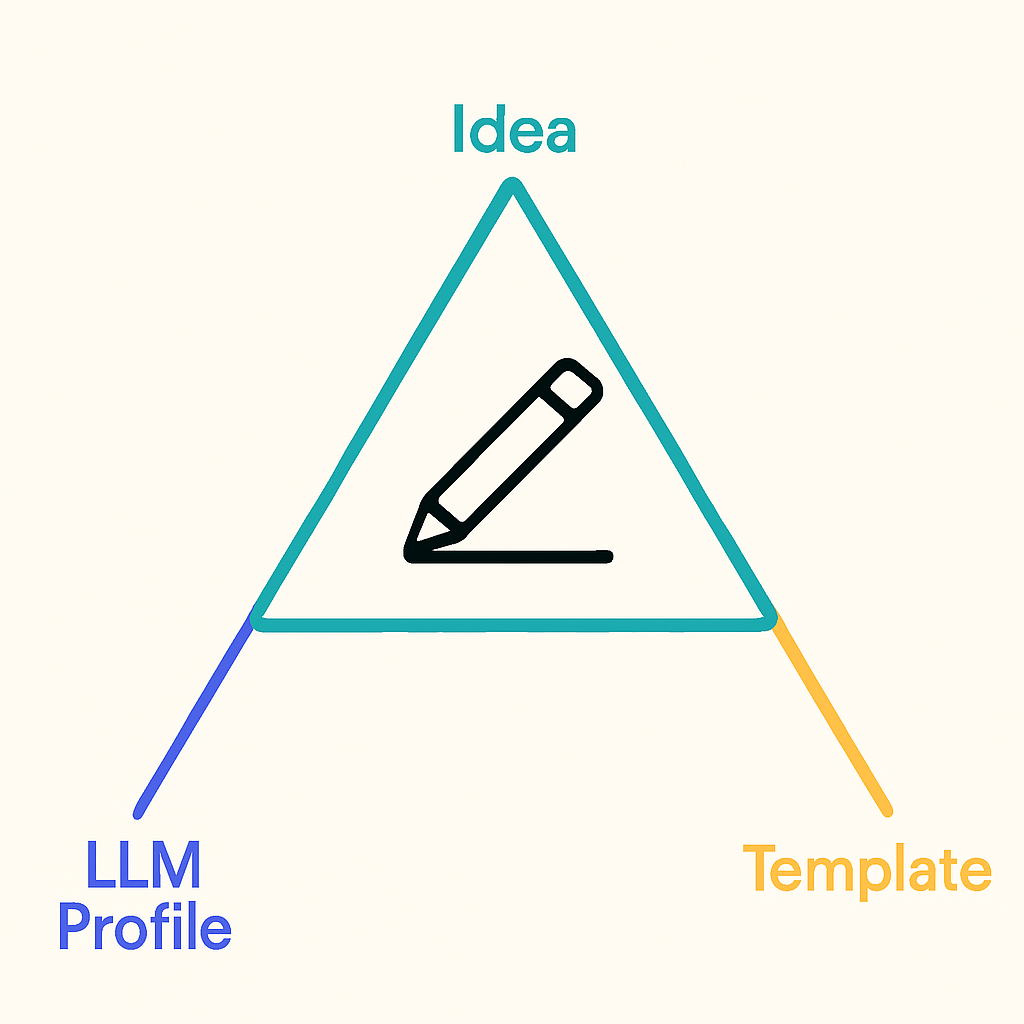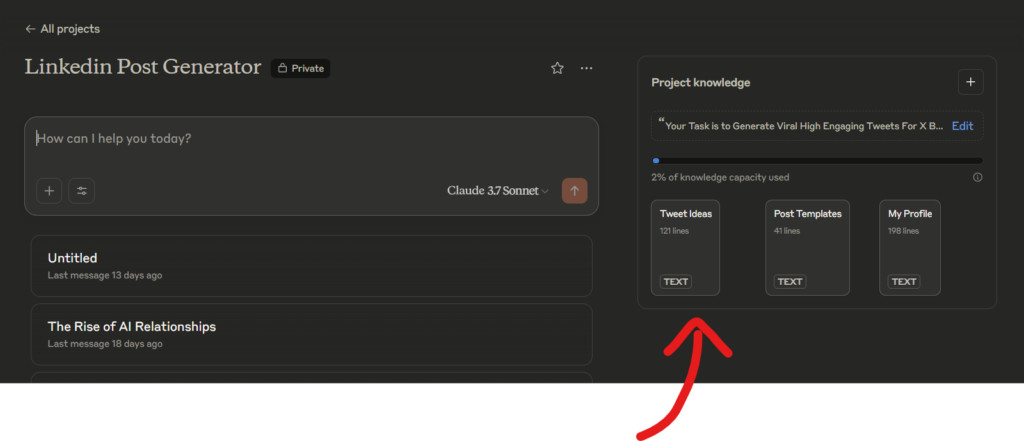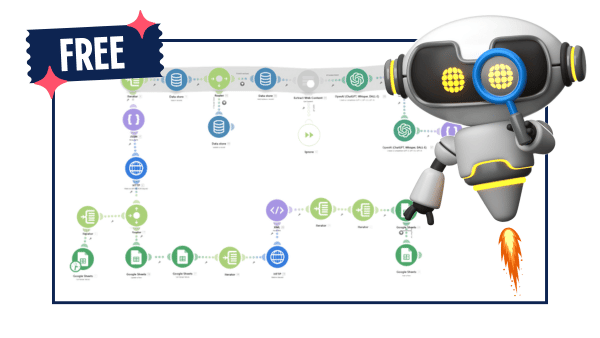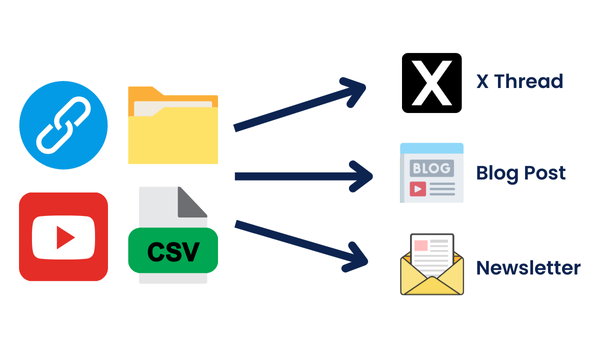How to Write Unique Blog Posts with AI: The Triangular Formula

Are you struggling to create consistent, high-quality blog content?
Do you want to use AI without sacrificing your unique voice and quality?
After years of experience in digital business and content creation, I’ve created a system that allows me to produce engaging, personalized blog posts in a fraction of the time it used to take.
In this post, I’ll share my triangular formula, the game changer in my content creation workflow!
The best part?
🤫 This very article was created using this exact method (bet you couldn't tell!).The Problem with AI-Generated Content
Most people approach AI writing tools with one of two mindsets:
- Total reliance: “AI, write me a blog post about X” (resulting in generic, duplicate content)
- Complete rejection: “AI can’t capture my voice, so I’ll write everything manually” (leading to content bottlenecks)
But there’s a better way!
The Triangular Formula: My Tested Solution
After months of experimentation, I’ve developed what I call the “Triangular Formula” for AI-enhanced content creation. It consists of three essential components:
- Idea – Your unique starting point
- LLM Profile – Your personal digital fingerprint
- Templates – Structural frameworks for consistency

Let’s break down each element:
1. The Idea: Your Unique Starting Point
The foundation of standout content isn’t technology—it’s experience. The most engaging posts come from:
- Personal experiments you’ve conducted
- Skills you’ve recently mastered
- Problems you’ve solved firsthand
- Insights you’ve gained through practice
For example, rather than asking AI to write a generic post about “Python automation,” share your experience automating your email marketing workflow with Python, including the challenges you faced and how you overcame them.
Pro tip: Before sitting down to write, jot down 2-3 key insights from your own experience that readers won’t find elsewhere.
2. The LLM Profile: Your Digital Fingerprint
This is the game-changer that most people miss. An LLM Profile is essentially a comprehensive document that captures:
- Your background and expertise
- Your teaching philosophy and communication style
- Your technical knowledge areas
- Your specific business offerings
- Your content structure preferences
- Your tone and writing quirks
When fed to an AI system, this profile acts as a style guide that transforms generic content into writing that sounds authentically like you.
Here’s a snapshot of what your LLM Profile might include:
## Personal Background I'm [Name], a [background] with [X] years in [industry]. My journey began as [previous role] before I [transformation]. ## Teaching Style & Philosophy - I explain complex concepts using [approach] - My content follows: [structure] - I emphasize [core beliefs] - I always share from personal experience, not theoretical knowledge - I believe in [communication style] ## Technical Expertise - [Skill 1] - [Skill 2] - [Skill 3] ## Business & Marketing Skills - [Skill 1] - [Skill 2] - [Skill 3]
For a complete example, check out my comprehensive LLM Profile here
3. Templates: Your Structural Framework
Templates provide the architectural blueprint for your content, ensuring consistency and reader engagement.
They guide the AI in organizing your ideas into compelling narratives.
Here are some examples of powerful template you can grab and go!
Example Templates:
The World’s Most Valuable Skill Is {Skill}.
Here Are 5 Frameworks To Help You Master It In Record Time
The world’s most valuable skill is [Skill].
Unfortunately, [Obstacle] keeps people from ever learning how to do it. They spend hours (and usually a ton of money) trying to learn [OldWay], all the while failing to realize the world has changed. The [OldWay] isn’t relevant anymore—because now, in order to be successful, you have to [NewWay].
I know, because I wasted [Time] and [Money] trying to learn this myself.
But, my loss is your gain.
Here are [X] [Topic] frameworks that will save you dozens of painful hours trying to learn [Skill] yourself:
[Name]’s [Topic] Framework
Hearing this completely changed the way I thought about [Topic].
According to [Name], all you have to do is:
[Step1]
[Step2]
[Step3]
[Name]’s [Topic] Framework
Hang this up in your room somewhere—and stare at it everyday.
[Tip1]
[Tip2]
[Tip3]
[Name]’s [Topic] Framework
I consider this the Bible of [Topic].
[Strategy1]
[Strategy2]
[Strategy3]
[Name]’s [Topic] Framework
Struggling with [Obstacle]?
[Step1]
[Step2]
[Step3]
[Name]’s [Topic] Framework
Finally, this is how you achieve [Outcome]:
[Tip1]
[Tip2]
[Tip3]
These [X] frameworks completely changed the way I thought about [Skill].
If only I had discovered them sooner…
Template: Main Points
In this first sentence, tell the reader what you are going to explain to them.
Next, break it down. Why is this important for the reader to understand? And what will happen to them as a result if they listen and learn from you? What benefits does this unlock in their life?
Now, let’s dive in.
Main Point #1:
Tell the reader why this matters.
Now, tell them a quick story or give them a quick example so they can see it in action. What are things like for someone who doesn’t do this vs someone who does? What’s the mini transformation that can occur?
Main Point #2:
Tell the reader why this matters.
Now, tell them a quick story or give them a quick example so they can see it in action. What are things like for someone who doesn’t do this vs someone who does? What’s the mini transformation that can occur?
Main Point #3:
Tell the reader why this matters.
Now, tell them a quick story or give them a quick example so they can see it in action. What are things like for someone who doesn’t do this vs someone who does? What’s the mini transformation that can occur?
Finally, tell the reader what you hope for them.
And wish them well on their journey forward.
{X} Mind-Boggling Stats About The {Niche} Industry—And How Fast It’s Growing
The [Niche] industry is on fire.
Some stats that will blow your mind:
[Stat1]
[Stat2]
[Stat3]
But it’s not until you break each of these down that you realize how quickly the [Niche] industry is really growing:
[Stat1]
This is an impressive stat at face value. But what’s 10x more impressive is [SecondaryStat]. That’s [X] times bigger than [ComparableIndustry].
This is a signal of where things might be headed.
[Stat2]
The last time an industry saw growth like this, it was in [Date] when [Niche] was [Outcome]. (Fun fact: [FunFact].)
And I’m betting the same thing will happen again here.
[Stat3]
As if the above wasn’t impressive enough, this stat is just mind-boggling.
To give you a sense of how big that is, that’s [EverydayComparison1]. Or [EverydayComparison2]. Or [EverydayComparison3].
Just to put things in perspective.
Final Prediction
My guess is that the [Niche] is going to eventually overtake [ComparableIndustry1] the same way [Niche] overtook [ComparableIndustry2]. And at this rate, that will probably happen by [Date].
What do you think? Do you agree? Disagree?
Let me know in the comments.
Putting It All Together: The Implementation
Here’s how to implement this system for your own content creation:
Step 1: Create a Dedicated AI Project
In your preferred AI tool (I recommend Claude AI for writing), create a new project specifically for blog creation.

Step 2: Load Your Triangle Components
Add these three elements as knowledge components to your project:
- Your idea notes (personal experiences/insights)
- Your LLM Profile document
- Your chosen content template
Step 3: Set Clear Instructions
Write a simple system prompt that explains exactly what you want, example:
Your Task is to help me write a full blog post ready for publish based on my draft.
My Niche: [Your niche]
Always ask questions before you generate the full post.Step 4: Generate, Review, and Refine
Run your generation and review the output.
You’ll likely be surprised at how well it captures your voice while expanding on your ideas in a structured way.
Advanced: Create Your Own Python Tool
For those who prefer a pay-as-you-go approach rather than subscriptions, you can create a simple Python project that interfaces with AI APIs. This allows you to:
- Generate content on demand
- Pay only for what you use
- Maintain a consistent system across different AI providers
Click the button to get a stater Prototype in Python to play with
The Benefits of This Approach
Implementing the triangular formula has transformed my content creation process:
- Time savings: I’ve cut my blog writing time by 70%
- Consistency: My posting schedule is now reliable
- Authenticity: Readers can’t distinguish between my AI-assisted and fully manual posts
- Focus: I spend more time on strategy and less on writing mechanics
Works in Any Language
One of the most powerful aspects of this approach is that it works regardless of your English proficiency. The AI will handle grammar and expression while preserving your ideas and style.
You can even generate content in multiple languages from the same inputs.
Final Thoughts
The key to using AI for content creation isn’t to replace your voice—it’s to amplify it.
By providing the AI with your unique experiences, a comprehensive style profile, and clear structural guidance, you create a system that produces content that’s unmistakably yours.
This approach allows you to be consistent in content creation, work faster, and focus on what truly matters: sharing valuable insights with your audience.
Want to Learn More?
Master AI Automation With Python Scripting: Join my comprehensive AI PE Course where you’ll learn to build tools like the content generation system described in this post.
Build Your Digital Business: Discover how content creation forms the heart of a successful online business in my Digital Business course.
Have Questions? join our free community, and let’s chat!







Responses